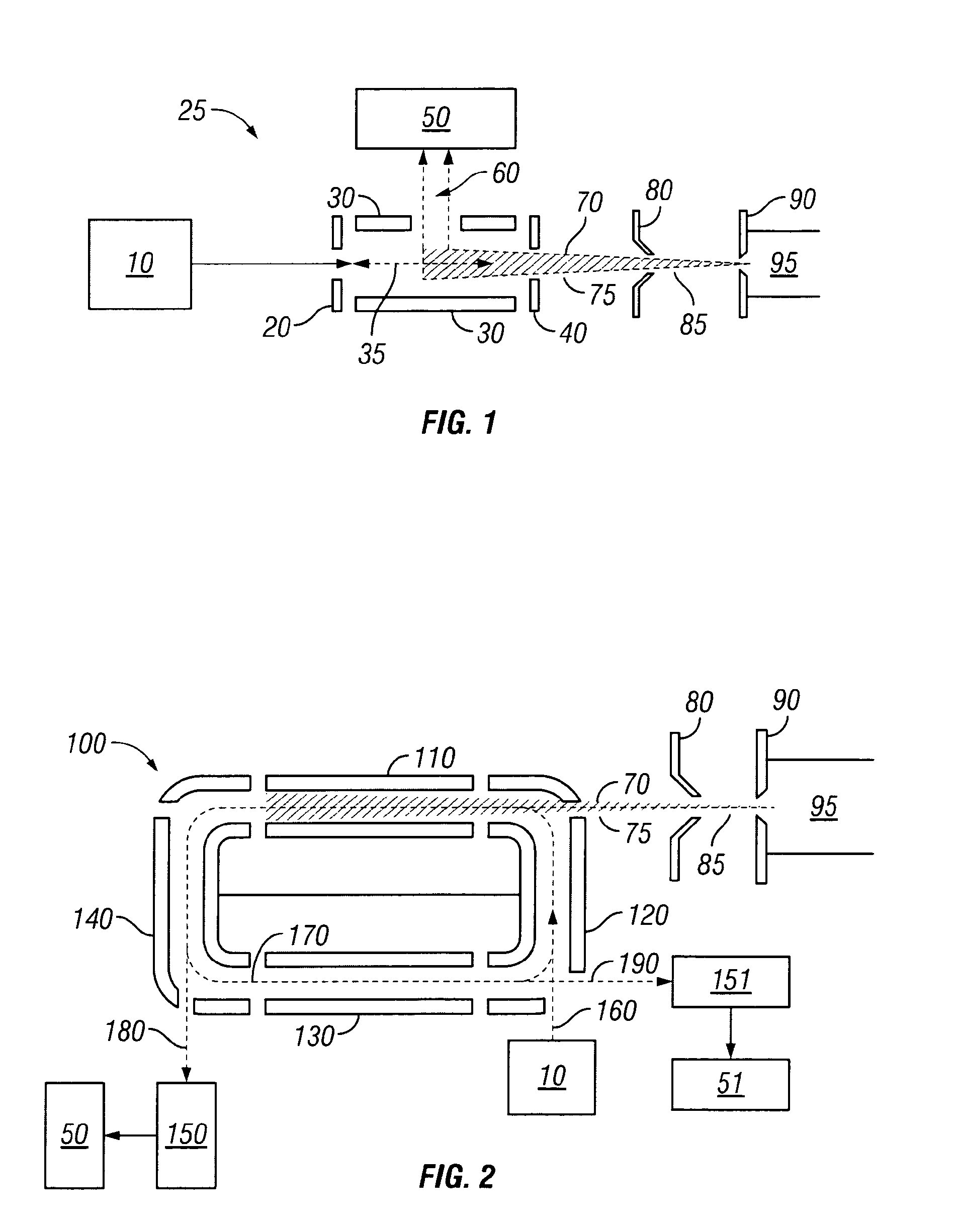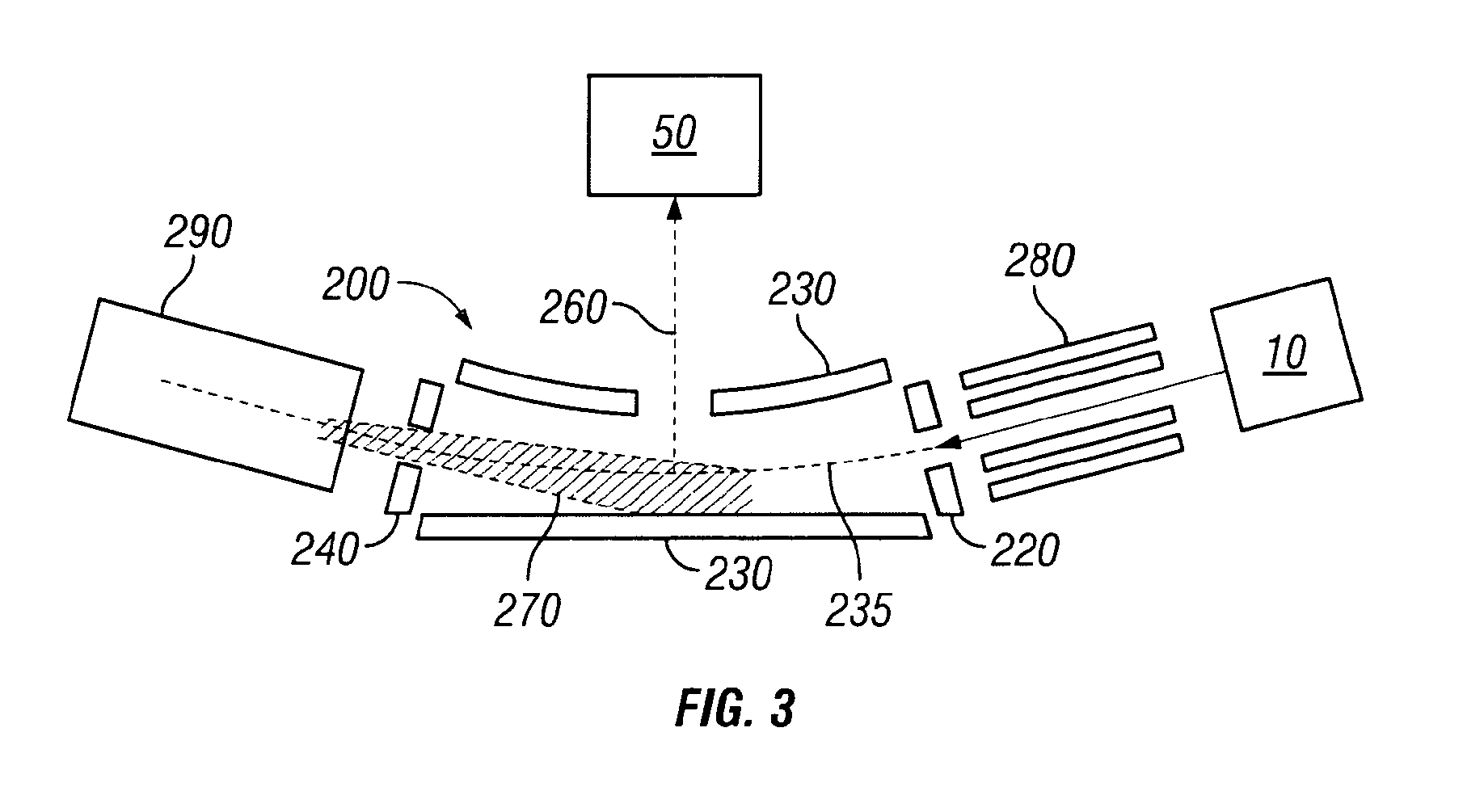Ion trap for cooling ions
a technology of ion traps and ion beams, which is applied in the field of ion traps, can solve the problems of limiting the minimum achievable emission of cooled ions, limiting the speed of operation, and limiting the gas emission rate of ions, so as to reduce the gas load of the analyser, save complexity and cost
- Summary
- Abstract
- Description
- Claims
- Application Information
AI Technical Summary
Benefits of technology
Problems solved by technology
Method used
Image
Examples
first embodiment
[0036]Referring first to FIG. 1, there is shown a mass spectrometer according to the invention. Ions are introduced from an ion source 10 through a first aperture 20 into an ion trap 25 defined by an extended set of rods 30, which are preferably quadrupolar. The rods 30 define a longitudinal axis 35, bounded by the first aperture 20 and a second aperture 40. Mass analyser 50 is provided adjacent the ion trap in a direction perpendicular to the longitudinal axis. An external gas line 95 is coupled to nozzle 90 and skimmer cone 80, adjacent to the nozzle, defines a differential pumping aperture.
[0037]An RF potential is applied to the rods 30 of the ion trap 25, such that the ions are directed along the longitudinal axis 35 of the ion trap. The ions are confined axially by voltages applied to first aperture 20 and second aperture 40. Gas enters the mass spectrometer from external gas line 95 through the nozzle 90 into a first pumping region 85. It thereby forms a gas jet 70 by superson...
second embodiment
[0043]An implementation of this principle is illustrated in FIG. 2, in which there is shown a mass spectrometer according to the present invention. Where the same features are shown as in FIG. 1, identical reference numerals are used. An ion trap 100 is formed in a race-track shape, comprising a first segment 110, second segment 120, third segment 130 and fourth segment 140.
[0044]Ions generated in ion source 10 are directed towards the ion trap 100. The potential applied to segment 120 of the ion trap 100 is switched off, for example, for several tens microseconds, to allow ions to arrive. Injected ions move along the circumference of ion trap 100. Gas jet 70 is generated through nozzle 90 and skimmer cone 80 and thereby directed towards segment 110. The ions trapped in the ion trap 100 periodically pass through the gas jet 70 and become more and more equilibrated with gas molecules, both in speed and temperature. It will be appreciated that directing of the beam through the trappin...
third embodiment
[0048]Referring to FIG. 3, there is shown a third embodiment according to the present invention. Where the same features are shown as in FIGS. 1 and 2, identical reference numerals are used. An ion trap 200 is provided which is of a C-trap form, as described e.g. in WO 2008 / 081334, defined by elongate electrodes 230 at least some of which are curved along their long axis. The elongate electrodes 230 define a long axis 235 of the trapping region which is thus slightly curved. A mass analyser 50 is provided adjacent the C-trap 200 in a direction orthogonal to the long axis 235 of the trapping region. The C-trap 200, like the ion trap 25 of FIG. 1, is open to its surroundings, which is not typical for ion traps which are normally operated at elevated pressure compared to their surroundings, the elevated pressure being maintained by an enclosure and a supply of collision gas. Instead the C-trap 200 is operated with a low internal pressure in the trap of typically about 1×10−4 mbar or le...
PUM
 Login to View More
Login to View More Abstract
Description
Claims
Application Information
 Login to View More
Login to View More - R&D
- Intellectual Property
- Life Sciences
- Materials
- Tech Scout
- Unparalleled Data Quality
- Higher Quality Content
- 60% Fewer Hallucinations
Browse by: Latest US Patents, China's latest patents, Technical Efficacy Thesaurus, Application Domain, Technology Topic, Popular Technical Reports.
© 2025 PatSnap. All rights reserved.Legal|Privacy policy|Modern Slavery Act Transparency Statement|Sitemap|About US| Contact US: help@patsnap.com



